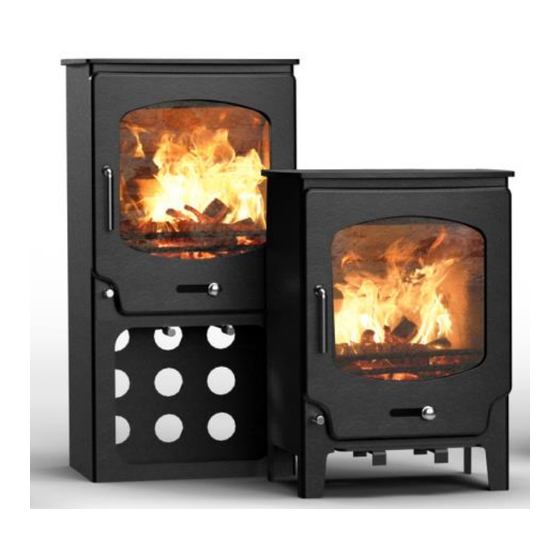
Table of Contents
Advertisement
Saltfire ST-X4, 5, 8
INSTALLATION AND OPERATING INSTRUCTIONS.
INTRODUCTION
SAFETY
Safety is the most important consideration when using and installing your stove. If not installed and used
correctly, a house fire could result. Installation must comply with relevant national and local Building
Regulations and fire safety standards.
IN THE EVENT OF CHIMNEY FIRE, EVACUATE THE PROPERTY AND CALL THE EMERGENCY SERVICES.
Your stove will be heavy, and care needs to be taken when lifting - 2 people will normally be required to lift.
UNPACKING
Your stove will have several of its components stored inside the stove itself for transportation.
The flue spigot can also be bolted to the flue outlet – the stove has two options for flue outlet – one on the
top and one at the rear. - Most people use the top outlet but depending on where you intend to position the
stove in relation to your chimney, you may wish to use the rear outlet – in this case, remove the blanking
plate at the rear and secure into the top outlet instead.
Underneath the grate will also be an ash-pan which will require regular emptying.
You will also find a glove which must be used when opening the door or when adjusting air vents when the
fire is hot.
1
Advertisement
Table of Contents

Summarization of Contents
Introduction to Saltfire Stoves
Safety Guidelines
Safety is the most important consideration when using and installing your stove to prevent house fires.
Unpacking Your Stove
Guidance on unpacking the stove, locating components, and identifying parts like the flue spigot and ash-pan.
Stove Installation Requirements
Compliance and Regulations
Stove installation must comply with local and national Building Regulations and fire safety standards.
Technical Specifications
Detailed technical data for ST-X4, ST-X5, and ST-X8 models, covering performance and safety standards.
Operating Your Saltfire Stove
Smoke Control Areas Compliance
Information on using the stove in smoke control areas under the Clean Air Act 1993.
Proper Refuelling Techniques
Guidance on refuelling to avoid excessive smoke, including low fire beds and fuel overloading.
Fuel and Air Inlet Controls
Approved Fuel Types
Details on suitable wood and smokeless coal types, including moisture content and prohibited fuels.
Air Inlet Control Operation
Explanation of the primary, secondary (airwash), and tertiary air inlet controls for combustion.
Lighting and Initial Use
Before First Lighting
Checks required before lighting the fire for the first time, including chimney and ventilation.
Paint Curing and Tempering
Essential instructions for initial paint curing and stove tempering to avoid damage.
Stove Ignition Procedure
Step-by-step guide for lighting the stove, including initial fire building and air vent adjustments.
Cleaning and Maintenance
Regular Maintenance Schedule
Step-by-step instructions for cleaning and maintaining the stove, including flue sweeping and baffle plate checks.
Cleaning Stove Components
Guidance on cleaning the glass, body, rope seals, and interior of the stove for optimal performance.
Troubleshooting Stove Problems
Difficulty Lighting or Keeping Lit
Common causes and solutions for issues with starting or maintaining a fire in the stove.
Fuel Burn Rate Issues
Diagnosing why fuel burns too quickly and potential remedies through vent control and fuel type.
Smoke and Glass Issues
Addressing smoke entering the room and causes for dirty glass, with troubleshooting steps.
Heat Output Problems
Identifying reasons for insufficient heat production or excessive heat in the room.
Chimney Fire and Safety
Actions During Chimney Fire
Essential steps to take in the event of a chimney fire, including cutting air supply and calling emergency services.
Contact Information
Details for contacting Saltfire Stoves for questions or concerns regarding safe stove use.
Warranty Information
Extended Warranty Details
Information on the 3-year limited warranty, registration process, and warranty validity.
Warranty Exclusions
List of items and conditions not covered by the stove's warranty, including consumables and misuse.



Need help?
Do you have a question about the ST-X5 and is the answer not in the manual?
Questions and answers